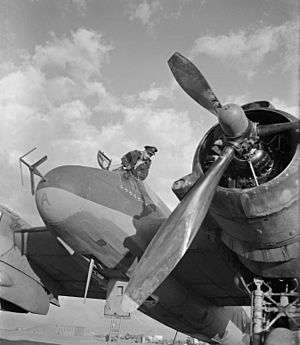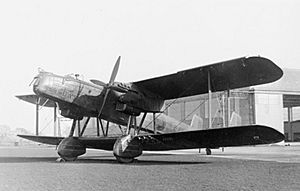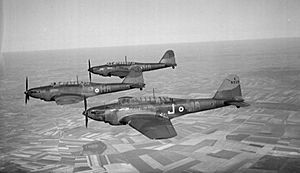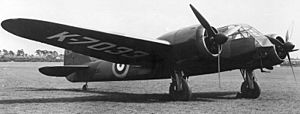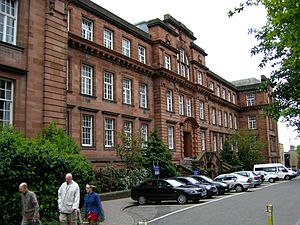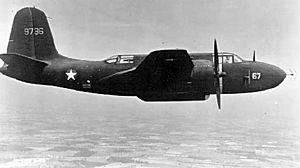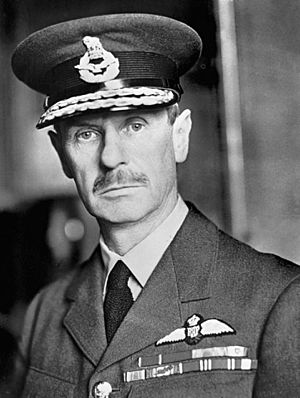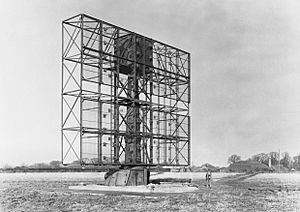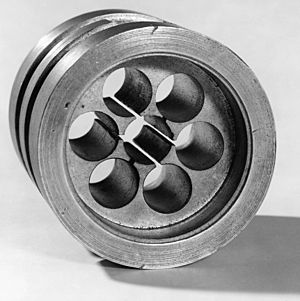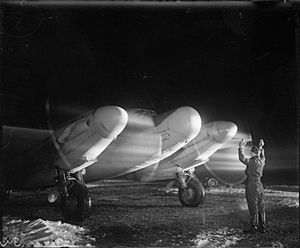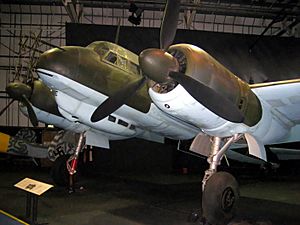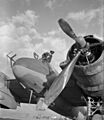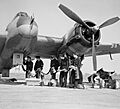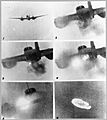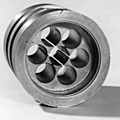AI Mark IV radar facts for kids
The AI Mk. IV (short for Airborne Interception Mark IV) was the world's first radar system designed to help planes find and track other planes in the air. It was like having special "eyes" that could see in the dark or through clouds. This radar was first used in July 1940 on Bristol Blenheim bombers. Later, it became widely used on the Bristol Beaufighter fighter plane by early 1941. Many historians believe the AI Mk. IV played a big part in stopping the Blitz. This was a time when the German air force (the Luftwaffe) bombed British cities at night during 1940 and 1941.
The idea for this radar came from Henry Tizard in 1936. He thought about how to fight enemy planes at night. Robert Watson-Watt, who led radar research, allowed physicist Edward "Taffy" Bowen to start a team to work on this. They had a test system flying later that year. However, it took four years to get it ready. This was due to moving locations, trying different designs, and disagreements among the leaders. Bowen eventually left the team just as the system was becoming ready.
The Mk. IV radar worked using radio waves at about 193 megahertz (MHz). This meant its waves were 1.5 meters long. It could spot large aircraft up to 20,000 feet (about 6 kilometers) away. But it had some challenges. For example, its maximum range changed with how high the plane was flying. Also, its minimum range (how close it could see) was very short. This made it hard for the pilot to see the target after the radar found it. The radar operator needed a lot of skill to understand the displays. As crews got better and new ground radars helped, the number of successful interceptions grew a lot in early 1941.
The Mk. IV was used on the front lines for only a short time. In 1940, a new invention called the cavity magnetron led to much better radar systems. These new radars used microwave frequencies. They were much more accurate and worked well even at low altitudes. The Mk. VII radar started to replace the Mk. IV by the end of 1941. By 1943, the AI Mk. VIII largely took over, moving the Mk. IV to less important jobs. However, parts of the Mk. IV's design, especially its receiver, were used in many other radar systems during the war.
Contents
- How the AI Mk. IV Radar Was Developed
- Early Ideas for Airborne Radar
- Why Night Radar Was Needed
- First Steps in Building Airborne Radar
- Testing on Planes
- New Tubes and Ship Detection
- Designing a Working AI System
- Dowding's Visit and the Blenheim
- AI Mk. I and Production Problems
- The "Pye Strip" and EF50 Tubes
- Moving Research Stations
- AI Mk. II and III
- AI Mk. IV: The Breakthrough
- How AI Mk. IV Was Used in Battle
- Further Developments
- How the AI Mk. IV Worked
- See Also
- Images for kids
How the AI Mk. IV Radar Was Developed
Early Ideas for Airborne Radar
By late 1935, Robert Watson-Watt and his team at Bawdsey Manor in England had created a radar system. It could detect large aircraft over 40 miles (64 km) away. Watt suggested building a chain of these radar stations along the British coast. This system, called Chain Home (CH), would give early warnings of enemy planes.
In 1936, the CH system was tested. Hugh Dowding, who would later lead RAF Fighter Command, noticed a problem. The CH stations gave so much information that it was hard for operators to tell pilots what was happening. Pilots also struggled to understand it. Dowding solved this by creating the Dowding system. This system used a special telephone network to send radar information to a central room. From there, it went to regional headquarters and then to pilots. But this process took time, and planes moved quickly. CH radars were also not very precise, only locating planes within about 5 miles (8 km). This was fine for daytime, but not for night.
Why Night Radar Was Needed
Henry Tizard, who helped start the CH system, worried that it would be too good. He thought the Luftwaffe would stop daylight attacks and switch to bombing at night. This had happened in World War I. Back then, trying to stop German bombers at night was very difficult. Tizard's worries turned out to be true.
Tizard knew that pilots could only see planes at night from about 1,000 feet (300 meters) away. The Dowding system couldn't provide that kind of accuracy. Also, ground observers wouldn't be able to spot planes at night. So, if planes were to be stopped, it had to be with radar. Tizard wrote to Dowding and Watt in April 1936. Watt then allowed Edward Bowen to form a group to put radar on planes themselves. This meant ground radars would only need to get the fighter close. The fighter's own radar would do the rest. This "Airborne Group" started in August 1936.
First Steps in Building Airborne Radar
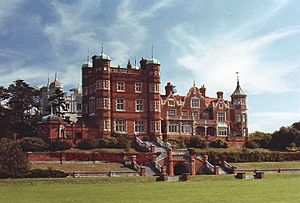
Bowen's team started by figuring out what an airborne radar needed. It had to be light (under 200 pounds or 90 kg), small (under 8 cubic feet or 0.2 cubic meters), and use little power (under 500 watts). The antennas also had to be small, less than 1 foot (30 cm) long.
They got lucky when they found a small, light receiver from EMI. It was made for early BBC television broadcasts. This receiver, with a display screen, weighed only 20 pounds (9 kg). It was much better than anything else available. They first tested it on the ground, detecting planes up to 50 miles (80 km) away.
Testing on Planes
Next, they needed a plane to carry the radar. They chose a Handley Page Heyford bomber. Its engines were well-shielded, meaning they didn't create much electrical noise that could mess with the radar. The antenna was a long cable stretched between the plane's landing gear. Batteries powered the receiver.
In autumn 1936, the system flew for the first time. It immediately detected planes 8 to 10 miles (13-16 km) away. Further tests pushed the range to 12 miles (19 km). This early system, called RDF 1.5, still needed ground transmitters to work. It also worked best when the target, fighter, and transmitter were in a straight line. Because of these limits, they decided to focus on designs where both the radar transmitter and receiver were on the fighter plane. Bowen later regretted this, thinking RDF 1.5 could have helped train night fighter crews earlier.
New Tubes and Ship Detection
In 1937, the team got new "acorn vacuum tubes" that could build more powerful transmitters. They put one on the Heyford. It wasn't great for air-to-air detection, but it surprisingly picked up docks and ships at Harwich International Port. This led to developing radar for detecting ships at sea, called Air-to-Surface-Vessel (ASV) radar. This was very successful. The team spent a lot of time on ASV radar in 1937 and 1938, which slowed down the airborne interception (AI) radar development.
Newer tubes allowed for even more power, detecting ships 12 to 15 miles (19-24 km) away. They also developed a special power supply to run all the radar parts from the plane's engine.
Designing a Working AI System
To test AI radar better, they needed a faster plane. In October 1938, they got two Fairey Battle bombers. These planes were more like night fighters in speed and size. By 1939, with war coming, the team focused back on AI. A new system, combining parts from ASV, flew in a Battle in May 1939. It could detect planes up to 3 miles (5 km) away, but the minimum range was still too long. This meant the radar couldn't see targets close enough for the pilot to spot them.
The problem was the "pulse width" of the radar. If the radar's signal was too long, it couldn't hear echoes from very close objects. It was like shouting and trying to hear a whisper right next to you. They worked hard to make the pulse shorter. They also had issues with ground reflections, where the radar signal bounced off the ground and created a false line on the display. This made it hard to see targets at low altitudes.
Dowding's Visit and the Blenheim
In May 1939, Hugh Dowding took a test flight. He was impressed but worried about the 1,000-foot (300-meter) minimum range. He wanted a night fighter that could stay in the air for a long time, had a separate radar operator (so the pilot's night vision wasn't ruined by looking at the screen), and powerful guns to destroy bombers quickly.
Dowding chose the Bristol Blenheim light bomber for immediate use, even though he thought the Bristol Beaufighter would be perfect later. Two Blenheims were sent for radar fitting.
AI Mk. I and Production Problems
The Mk. I radar used multiple receiver antennas to figure out the target's direction. Two horizontal antennas saw targets to the left or right, and two vertical ones saw targets above or below. A fast switch moved between these antennas, and the signals showed up on a screen. If the target was to the left, a longer blip appeared on the left side of the screen. This wasn't super accurate (about 5 degrees), but it worked.
The Air Ministry urgently wanted the radar in service. In June 1939, AI was given top priority. However, the parts came from different companies, and they weren't always right. The receivers, for example, were too heavy and not sensitive enough.
The "Pye Strip" and EF50 Tubes
The team got lucky again when they found a new, much better receiver design from Pye Ltd., a radio company. This design used a special vacuum tube called the EF50. It was a huge improvement. The EF50 became so important that when Germany threatened to invade the Netherlands in 1940, the British quickly arranged to get 25,000 EF50 tubes and the company's directors out of the country on a destroyer.
New Blenheims arrived, converted into heavy fighters with machine guns and cannons. The radar had to be refitted for these new planes. The displays were put in the enlarged nose, allowing the operator to signal the pilot. But Dowding worried that enemy gunners would see the light from the screens. So, the sets were moved back to the rear of the plane, causing more delays. Communication between the pilot and operator was also a problem due to radio interference.
Moving Research Stations
When war broke out in September 1939, the radar research teams had to move from Bawdsey Manor, which was too exposed to attack. They went to Dundee University, but there wasn't enough space. The AI group moved to an airport in Perth, Scotland, which was also not ideal. Conditions were very basic, with planes often left outside.
Bernard Lovell, a physicist, joined the team and complained about the poor conditions. This led to another move, this time to MOD St Athan in Wales. But St Athan was also difficult, with the team working in a cold, disused hangar. Ironically, Bawdsey was never attacked, while St Athan was bombed shortly after they arrived.
AI Mk. II and III
The AI Mk. II was planned to have a shorter minimum range, but it ended up being longer. They tried two experimental versions, but development stopped. In May 1940, several squadrons got Mk. II-equipped Blenheims.
Bowen pointed out that night fighters needed to be much faster than their targets. The Blenheim, at 280 mph, was too slow for the 250 mph German bombers. This was proven true in combat.
The Mk. III replaced the transmitter with a more powerful one. It had a better maximum range (3-4 miles or 5-6 km) but still a long minimum range. This led to arguments about how to fix the minimum range problem. Bowen was eventually removed from the AI project.
AI Mk. IV: The Breakthrough

Engineers Alan Blumlein and Eric White at EMI developed a new system. It made the radar pulse sharper and reduced unwanted signals. In May 1940, tests showed it could see targets clearly at 500 feet (150 meters) and even at 400 feet (120 meters). This was a huge improvement.
The new AI Mk. IV was first tested in July 1940. It could detect another Blenheim at 20,000 feet (6 km) and track it down to 500 feet (150 meters). It finally did "everything that we had originally hoped that airborne radar would do for night-fighting." Production of 3,000 units started immediately.
The British shared this technology with the US and Canada. In the US, it was called the SCR-540 and was used on planes like the P-70 Havoc and PV-1 Ventura starting in 1942.
How AI Mk. IV Was Used in Battle
First Successes
The AI Mk. IV was crucial for night fighting. Radar operators on the ground at Chain Home (CH) stations could now talk directly to the fighter pilots, cutting down delays. This helped a lot.
The first confirmed success using airborne radar happened on the night of July 22/23, 1940. A Blenheim from the Fighter Interception Unit (FIU) was guided by the Poling CH station. It picked up a German Do 17 bomber at 8,000 feet (2.4 km). The pilot got close, fired, and the bomber crashed. This was a historic moment.
However, the Blenheim was still too slow. German bombers could often escape. From October 1 to 15, 1940, Blenheims made 92 flights and 28 radar interceptions, but got zero kills.
The arrival of the faster, more powerful Bristol Beaufighter in August 1940 changed everything. It had strong engines and four 20 mm cannons. The first victory for a Beaufighter with AI Mk. IV came on November 19/20, 1940, when it destroyed a Ju 88 bomber.
The Blitz and Dowding's Dismissal
After losing the Battle of Britain in daylight, the Luftwaffe started the night bombing campaign known as The Blitz in September 1940. In September, the Luftwaffe flew over 6,000 night missions but lost only four planes in combat. The Dowding system couldn't handle night interceptions well.
Hugh Dowding insisted that AI radar was the only real solution. But others wanted different ideas, like using searchlights to help fighters see targets. Dowding was criticized for this and other reasons. He was eventually removed from his command on November 24, 1940. Many historians believe his focus on AI radar was correct in the long run.
Ground Control Interception (GCI) Radar
A big problem was that AI radar's maximum range was limited by the fighter's altitude. This meant German planes flying low could escape. Also, there wasn't much ground radar coverage over land.
In November 1939, Robert Hanbury Brown suggested a new type of ground radar. This radar would show both the target and the fighter on the same screen, like a map. Ground controllers could then guide the fighter directly. This new radar, called Ground Control Interception (GCI), used a rotating antenna. The display screen would also rotate, showing all targets in a map-like view.
The first GCI stations became operational in January 1941. Before GCI, the interception rate was very low. By May 1941, with GCI stations and better training, it rose to 7%, with a kill rate of about 2.5%.
Ending The Blitz
The combination of AI Mk. IV, the Beaufighter, and GCI radars finally created a truly effective night fighting system. As crews got better, the number of planes shot down increased quickly:
- January 1941: 3 planes shot down.
- February: 4 planes.
- March: 22 planes.
- April: 48 planes.
- May: 96 planes.
By June, AI-equipped fighters were responsible for almost all kills. The Luftwaffe ended The Blitz at the end of May 1941. While the night fighters helped, the Germans were also shifting their focus to fighting in the east.
Baedeker Blitz
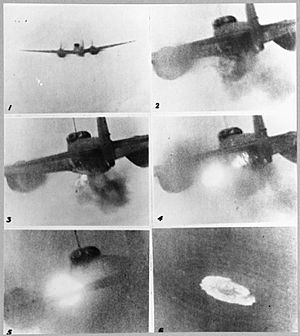
In 1942, Germany started the "Baedeker Blitz" in response to British bombings. They targeted historic British cities. The first raids surprised the British. But as the pattern of attacks became clear, the defense improved. However, the German bombers often flew low, climbed to drop bombs, and then dived again. This meant AI Mk. IV interceptions were only possible during the short bombing run.
The Baedeker raids caused damage but didn't stop British bombing of Germany. Night fighters shot down about 22 German planes during this time.
Replacing the Mk. IV
Scientists had been experimenting with microwave radar since 1938. In February 1940, John Randall and Harry Boot created the cavity magnetron. This small device could generate powerful microwave signals. At these short wavelengths, antennas could be much smaller and create very narrow beams. This meant the radar could avoid ground reflections and see targets at any altitude.
The magnetron led to the AI, Sentimetric (AIS) system, which became the AI Mk. VII. The first production version arrived in February 1942. The first kill by a Mk. VII was in June 1942.
Serrate: Hunting German Radars
As new microwave radars came out, the British looked for new uses for older Mk. IV systems. One idea was to use them to find German radar signals. In December 1942, the British found out the frequencies of the German FuG 202 Lichtenstein BC radar.
The Mk. IV's antennas were almost perfect for picking up these German radar signals. By replacing the receiver unit, the Mk. IV could become a "Serrate" system. Serrate could track enemy fighters up to 50 miles (80 km) away. Since it was just listening to the enemy's radar, it couldn't tell the exact distance. So, Serrate was used for the initial tracking, and the fighter's own radar was used for the final approach.
Serrate was first used in June 1943. By September, 14 German fighters were shot down. However, the Beaufighter was still too slow for some German planes. De Havilland Mosquito fighters, which were faster, began to replace them. The Germans soon developed new radars that Serrate couldn't detect as easily.
Further Developments
Mk. IVA and Mk. V: Pilot Displays
Pilots found it hard to get close to targets using only the radar operator's instructions. In 1940, Robert Hanbury Brown suggested adding a display for the pilot. This led to the Mk. IVA. The radar operator would select a target on their screen, and a single dot would appear on the pilot's display. If the dot was above and to the right, the pilot knew to turn right and climb.
Tests started in October 1940. The pilot's display also showed range information. A line would grow longer as the fighter got closer to the target, like growing wings. Special lines on the display told the pilot when to slow down, when to look for the target, and when to break away to avoid a crash.
The Mk. IVA was produced as an add-on for existing Mk. IV systems. Later, the Mk. V was a redesigned unit with improvements. It was fitted to the de Havilland Mosquito starting in April 1942. However, pilots still found it hard to look up from the display at the last minute. With microwave radars becoming available, Mk. V production was eventually cancelled.
Mk. VI: For Single-Engine Fighters
The RAF wanted to put radar on single-engine, single-seat fighters. The AI Mk. VI was designed for this. It was like a Mk. IVA but with an automatic system to find targets. The radar would sweep for targets. If it found one, it would "stick" to it, showing it on the pilot's display. The pilot would then intercept the target.
Prototypes were made in October 1940. There were many problems, like the radar sticking to ground reflections or the wrong target. A "panacea button" was added to fix this. Production started in December, but more problems were found. It wasn't until December 1941 that the units were ready for squadron use.
By this time, more Beaufighters and Mosquitoes were available. Single-engine fighters were removed from night fighter units in 1942. Some Mk. VI units were used overseas, like on Hawker Hurricanes in India, where they shot down some Japanese bombers. An experimental fit on a Hawker Typhoon was also tested, with the radar packed into a fuel tank under the wing.
How the AI Mk. IV Worked
The Mk. IV was a complex system, officially called the Airborne Radio Installation 5003 (ARI 5003). It had many parts, including a receiver, transmitter, modulator, and different antennas for elevation and azimuth.
Antenna Design
The Mk. IV used Yagi antennas, which were good for single frequencies. The transmitter had a single "arrowhead" antenna on the nose of the plane. For receiving signals, there were four antennas. Two were mounted above and below the wing for vertical reception (elevation). Two were mounted on the leading edge of the wing for horizontal reception (azimuth). The plane's body and engine parts helped block signals, making the antennas more directional.
All four receiver antennas were connected to a motor-driven switch. This switch rapidly selected each antenna, sending its signal to the display screen. This allowed the operator to see if the target was to the left, right, above, or below. The Mk. IV's antenna setup was simple compared to the German Lichtenstein radar, which used a large "mattress" of 32 antennas.
Serrate Operation
Serrate used the Mk. IV's display and parts, but with a new receiver tuned to German radar frequencies. The operator could switch Serrate on or off. When on, it turned off the Mk. IV's own transmitter. The operator would use Serrate to track German fighters, guiding the pilot. Since it only listened to the enemy's signal, it couldn't tell the exact range. The operator would estimate the range by signal strength. Once close enough (about 6,000 feet or 1.8 km), the fighter's own radar would be turned on for the final approach.
IFF Use
Starting in 1940, British planes had IFF Mk. II systems. IFF stands for "Identify Friend or Foe." It helped radar operators tell if a blip on their screen was a friendly plane. When a radar signal hit an IFF-equipped plane, the IFF would send out a special radio pulse. This pulse would mix with the radar's own signal, making the blip on the screen look different, like a stretched-out rectangle. This showed it was a friendly aircraft.
Homing Systems
Transponder systems on the ground allowed planes to home in on their location. These were used with the Mk. IV. When the radar signal hit a transponder, it would send back a short pulse on the same frequency. This pulse would appear as a sharp blip on the Mk. IV's display. The operator could guide the plane to the transponder using the same methods as finding an enemy aircraft.
BABS: Landing Aid
Another system used with the Mk. IV was the Beam-Approach Beacon System (BABS). This helped pilots land in bad weather by showing the runway centerline. BABS worked by sending out pulses that the Mk. IV could pick up. If the plane was to the left of the runway, the operator would see a certain pattern of blips. If to the right, a different pattern. When on the centerline, the blips would form a continuous line. This was called "AI beam approach" (AIBA).
See Also
- Air warfare of World War II
- European theatre of World War II
- History of radar
- Turbinlite
- Air Ministry Experimental Station (AMES)
Images for kids
-
Bowen's first 6.7 m set broadcast from the Red Tower to the White Tower, both visible on the left side of this image of Bawdsey Manor.
-
The Bristol Beaufighter solved Dowding's concerns about armament, carrying both machine guns and a quartet of 20 mm cannon.
-
One effort to close the minimum range gap was to use a searchlight, as is the case on this Havoc mounting a Turbinlite in its nose. Note the Mk. IV antennas on either side. The Mk. IV guided the Havoc to close range and then the light was switched on, illuminating the target for other fighters to attack.
-
Hurricanes, like this Mk. IIC of 87 Sqn, were widely used as night fighters until 1942. Their success in this role was limited.
-
Night fighters were used in bad weather, and were sometimes known as night/all-weather fighters for this reason. This sequence shows a Junkers Ju 88 being shot down in bad weather by a Mk. IV-equipped Mosquito NF Mk. II over the Bay of Biscay.


